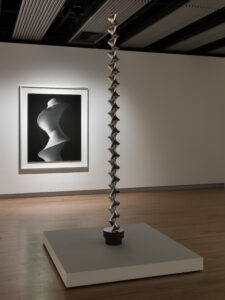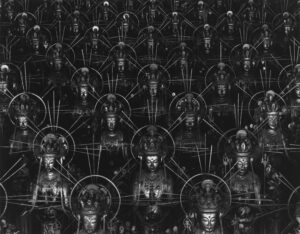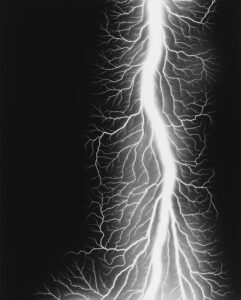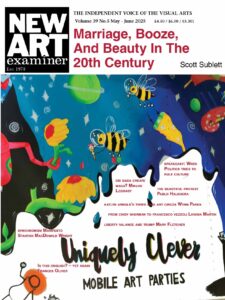Hiroshi Sugimoto at the Hayward
Nancy Nesvet

Defining photography as the merging of science, its original purpose and discipline, with art as it soon became, Hiroshi Sugimoto for decades has examined photography as a medium and an end, an art form and an outpouring of the soul or mind, his and ours as he draws us into the consideration of mortality and the beginning and future of the earth. His work is a compendium of the earth’s history, from the original darkness of the miasma, as the seas formed enveloping the earth, and life itself as documented in the dioramas at the Natural History Museum in New York, a body of work that memorialized past times and animal life. He visualizes and universalizes his vision of life on earth, and using photography, explains mathematically conceived form. Each photograph, each explanation is from his point of view, at a specific place. He composes the image from what he sees through the camera lens. As his seascapes lack specific geolocation or landmarks, the specific becomes universal. Photography repeats the original image with slight changes, for posterity, for all of us and future generations.
Sugimoto is a Renaissance man in a contemporary world. As much as Leonardo da Vinci combined science and art, bringing each discipline and knowledge to the other, Sugimoto has brought visions of the sea, conceptual forms become concrete, technology of film suppressing hours into the blast of light that is photography and filmmaking itself. He questions sculptural models to impart knowledge of mammalian history and more to his constant examination of natural and physical history on earth and in the universe.
The primeval-appearing spirals of white plaster in Sugimoto’s photographed conceptual forms, from mathematical models at the University of Tokyo’s Graduate School of Mathematical Sciences are derived from concepts and ideas relative to the physical world. Relating to the system they created, the realized forms from abstract mathematical calculations account for surfaces of revolution with constant negative curvatures, varied by twisting and varying types. They are reminiscent and congruent with Mobius strips and Klein bottles, and the shapes of corals, kelps, nautilus and other seashells and forms recently and yet to be discovered in the universe and below the seas. Sugimoto makes these conceptually derived forms art as the conceptual becomes concrete. Where some of the models that Sugimoto photographed had pieces broken off, were imperfect not adhering to the mathematical model, Sugimoto realized and perfected them, literally filling in the gaps. The new sculptures, in stainless steel where he could repair, make whole and perfect forms like Surface of Revolution with Constant Negative Curvature look like Mount Fuji’s apex with the sculpture’s impossibly narrow millimeter wide tip, reimagining the mathematical model he based it on. He has said, ‘I feel like I’m carving this out of conceptual form’ and he is. Like mathematics and physics conceptualizing the beginnings of the universe, he visualizes the calculations and formulae. But then he creates a surface of revolution by revolving the form, creating the push and pull of creating a pseudosphere, the opposite of a sphere with the negative curvature of crenellated prehistoric sea creatures. It is those shapes that bring us full circle to Sugimoto’s aim; to document historic and prehistoric creation and generation of earth and its creatures, ending with mankind, and the Buddhas.
His seascapes, bisected almost equally between sea and sky, differentiate the worlds as the Bible re-counts at the dawn of time, with the waters of the earth created on the second day. From then until contemporary time, the millenia are compressed, here into seven photographs. His ‘Theatre and Drive-Ins Series’, with films compressed from two hours or more of viewing time, into a flash, a second, are like the beginning of time and the earth, deriving from a single flash, accounted for in religious and scientific tracts, leading to millenia of existence. It is as if he is constructing the earth from the miasma from which it began. The ‘Seascapes’ refer to different bodies of water; The English Channel, from the Weston Cliff (1994) the East China Sea, Amakusa, (1992) Aegean Sea, Pilion, 1990) Boden Sea, Uttwill (1993), North Atlantic Ocean, from Cape Breton Island (1996) Bass Strait, from Table Cape, (1997) and more, including lakes and waterfalls. Created with long exposures, Sugimoto asks modern people to see the world as the ancients saw it, extending that moment of time across the centuries to our time. At Kegon Falls in Japan, where he returned in 1977, he photographed the waterfall through the mist and light drizzle of rain. That night, in the mountains of Okunikko National Park, he ‘felt memories of a time when people lived in the forest come back to life in my blood’ The inspiration for the ‘Seascapes’ series was born there. He wrote: ‘A cloudless sky, a sharp horizon, gentle waves. My thoughts continued. Where do these ancient sensations that I feel come from? I wondered if it was possible for modern people to see the landscapes that ancient people once saw. Then I realized it must be the sea.’ His vision, his way of seeing, of formulating a view, common to concepts in Zen Buddhism, revering nature seem met with Judao-Christian creation stories, from the religion of his mother, to lead him to the Japanese minimalist aesthetic and his questioning of the structure and origins of the universe and its perpetuity as originally envisioned in our and his time. He has said, ‘I photograph to confirm my vision, to melt the time-melt the motion. Sugimoto is a historian, a documentarian of all time. His box camera inspired the title of the show, ‘Time Machine’.

The ‘Portraits’ series (1994), features photographs of wax sculptures of leaders and celebrities, including Henry VIII, Salvador Dali, Napoleon Bonaparte, Duke of Wellington, Oscar Wilde, Yasser Arafat, Fidel Castro, Queen Victoria, Diana, Princess of Wales and Queen Elizabeth II and the ballerina, Darcy Bussell. All made in 1999 they are beautifully detailed photographs made with Sugimoto’s land camera, the silvers shining through the black and whites. The figures are against a black background, analogous to no age but the one they influenced, identified by the medals and icons referring to their histories. There is a feeling of closed history, of those no longer a part of the world we live in. In the same ‘Portraits’ series, the notorious in Madame Tussaud’s Chamber of Horrors are photographed. The depictions include murderers and the actual Electric Chair that held the Lindbergh baby’s kidnapper that now holds a waxwork of him. Here, Sugimoto questions not only the representation of life and reality, which is photography, but also, Tussaud’s contention that the wax sculptures were taken from life. They were taken from death masks of those no longer alive. Time has stopped. Figures will not live nor breathe again. Appearance will be the same for eternity, as in the photograph which freezes time and currents of water and spiraling of ceramic forms. Photographs, as waxworks and other forms of artistic representation, allow people and nature to remain in the world for future generations. Again, Sugimoto is the documentarian, the historian with a sense of nostalgia for what has gone before and will never be again. Against his continuous peaceful seas, which will hopefully go on forever, which we witness as they were long ago, these portraits, standing apart from us, have a closed history, as death deems their lives done, their bodies buried, their acts judged. They cannot change anything. Their lives, done, are inscribed as the static photograph; the dead are unchanging, as are the wax works. Yet In the repetitive process of image making and remembering that changes slightly with each iteration of the photograph, by each creator, their image and memory is saved from ultimate death. We observe a world that we can only know in visualizations and concepts, as our actual world changes. Sugimoto’s ‘Architecture’ series’ photographs are blurred. Only the Seascapes are as amorphous as the blurred buildings, and perhaps for the same reason. As the sea is constantly changing, not a static image that can be photographed with crisp, never changing outlines, buildings change, erode over time, react to the atmosphere, the light, and surroundings they are in, as does the sea. Begun in 1997, the photographs of the Chrysler Building, the World Trade Center, the Seagram Building, the soaring angles of Notre Dame du Haut, the Brooklyn Bridge have been described by Sugimoto as his effort to discern the original vision of the architect in creating his vision for the building, his impetus for their slight blurriness. Like the later ‘Conceptual Forms and Mathematical Models’ series, the original vision of the architect is later refined, made physically possible owing to scientific and mathematical conception and formulae, uniting primary artistic vision of possibility with mathematical, scientific reality to create the concrete object, here a building. Yet in this series, as opposed to the sea photographs, there is a sense of erosion, that these buildings will not remain intact forever, and as we know, the World Trade Center did not. But Sugimoto does not deal with catastrophic destruction: his issue is time and how time remains constant but buildings, land, civilization changes, erodes but remains in perhaps a different form. Photography documents what once was, and in some of the photographs, what is becoming, but always preserves a moment in time.
Like the conceptual forms, missing pieces, not as smooth as the later stainless-steel forms, the buildings are a blurry concept at first, as expressed in the photographs. In the photographs of historic theaters and movie houses, in the series, ‘Theatres and Drive-Ins’ there are no backgrounds, no references to the time the photographs were made. Theater seating lacks an audience; no witnesses to the film or performance are portrayed. There is a haunting absence and a lack of historic orientation that makes them timeless, with only the photographer to record the memory.

Sugimoto, a photographer, documents and makes copies of everything his camera can record, more than the human eye can see. But he visualizes the story of mankind, and earth, and the seas and universe from its inception, from the conceptual vision and electric charge that created our world, and the attempt at perfecting it, as shown in the ‘Conceptual Forms and Mathematical Models’ series. Again, in the ‘Portraits’, Sugimoto photographs smooth, perfect wax renditions of flawed people, and recreates the story of civilization by photographing dioramas in the Natural History Museum, hinting at expanding the progeny of Ostrich-Wart Hogs, Alaskan Wolves, Manatees, one of the earliest species, and of apes, which he titles ‘Earliest Human Relatives’, California Condors, Hyena, Jackal, Vultures and Polar Bears This could only lead to the ‘Sea of Buddha’ series. Their myriad images, both physical and photographed, are each slightly different. Sugimoto is not the creator, nor the perfector, but the recorder, the historian, the interpreter of the creation and the ongoing evolution of earth and its inhabitants, the causes and results of that creation and evolution. ‘Sea of Buddhas’ is not randomly called a sea. Sugimoto’s first sea photographs each featured a similar image of a body of water, but varied according to which particular body of water was depicted. Each varied according to the light, location, degree of wave or passivity of the water. There were imperfections in the waves; they were not regular nor symmetrical. The Buddhas were photographed in Sanjusangendo, the Hall of Thirty-three Bays, part of the Buddhist Temple in Kyoto where 1,001 Senju Kannon, each eleven-headed late twelfth and early thirteenth century sculptures of the Thousand-Armed Bodhisattva Avalokitesvara who helps the suffering and dying into the afterlife, reside. Sugimoto stripped the hall of all medieval and early modern period accouterments and artificial light and depended on the rising sunlight over the Higashiyama Hills to light the Buddhas in the darkened room. The 1,001 Senju Kanon each differ slightly and are not perfect sculptures; they depict imperfect beings; conceding imperfection of all beings, and all nature. It is this repetition, of the seas, of the Buddhas, of mathematically programmed shapes, of all in our imperfect world that Sugimoto photographs as he makes clear that we repeat, over generations imperfections, which the camera records.
The final room exhibits the ‘Opticks series’ from Sir Isaac Newton’s treatise, Optics, or a ‘Reflection of the Reflexions, Refractions, Inflexions and Colour of Light’ exploring properties of sunlight Newton ultimately proved, with scientific experimental corroboration of his hypothesis, that white light divides into seven colors of the visible spectrum, present within the light itself rather than reflected or refracted. Sugimoto used a glass prism to recreate. Newton’s experiment, rising at dawn to see and later photograph the spectrum of light. He later split each color into variations within that color, seeing the slight changes within the primary color. Just as he had photographed the miniscule changes in the different seas, or the slight changes in the Buddhas, the changes in the spectral colors led to variations in each repetition, just as photographs do. Appearing to shimmer, vibrate as one color approaches the next, like Rothko’s paintings, these are photographs of pure light, photography, writing in light. Throughout his career, he has explained the essence of photography, the progression from the photographed subject to the negative to the positive image, to later repetitions of the photograph. Here he treats the science that is photography. Relegated to history, the final shipment of Polaroid film to ever be produced was sent to him to be used in the ‘Opticks’ series. The Buddhas and their imaging are equally relegated to history, as are the people in the Portraits series, the views of the seas, or the strikes of lightning never to again be reproduced.
I wanted the entire exhibition to mimic the dark, cavelike room of the Buddhas, to come from the miasma like darkness of the dawn of creation, with flashes of lightning, ancient seas, unchanged, and past lives, to the Buddha’s cave. A white-walled museum is not the perfect venue for this art. Years ago, in the Hirshhorn Museum lobby in Washington, DC which Sugimoto redesigned, two 700-year-old Japanese chestnut tree roots, each supported an optic glass, one shaped like the Ying symbol; one the Yang, Sugimoto told me of the museum he had designed in Japan. The Odawara Art Foundation and Enoura Observatory, overlooking Sagami Bay in Japan, floats above the sea, showcasing his minimalist photography. A stage built by heaping Nebukawara stones, on which Noh drama is performed, ancient gates and other structures provide an overview of Japan’s architectural history, connecting the present with the ancient past. I asked Sugimoto why he built a museum and he replied, with the chuckle that always ends his sentences, ‘because I didn’t like anyone else’s.’ His vision is unique and unlike the elements in the art he photographs, and the repetition of images in his oeuvre, unreproducible
Hiroshi Sugimoto
Hayward Gallery, London
11 Oct 2023 – 7 Jan 2024
Art & exhibitions
£18, Free for Members

